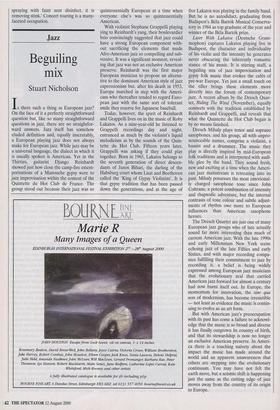Jazz
Beguiling mix
Stuart Nicholson
Is there such a thing as European jazz? On the face of it a perfectly straightforward question but, like so many straightforward questions in jazz, there are no straightfor- ward answers. Jazz itself has somehow eluded definition and, equally inscrutably, a European playing jazz does not always make for European jazz. While jazz may be a universal language, the dialect in which it is usually spoken is American. Yet in the Thirties, guitarist Django Reinhardt showed just how close the camp-fire extem- porisations of a Manouche gypsy were to jazz improvisation within the context of the Quintette du Hot Club de France. The group stood out because their jazz was so quintessentially European at a time when everyone else's was so quintessentially American.
With violinist Stephane Grappelli playing ying to Reinhardt's yang, their boulevardier brio convincingly suggested that jazz could have a strong European component with- out sacrificing the elements that made Afro-American jazz so compelling and sub- versive. It was a significant moment, reveal- ing that jazz was not an exclusive American preserve. Reinhardt was the first major European musician to propose an alterna- tive to the dominant American style of jazz expressionism but, after his death in 1953, Europe marched in step with the Ameri- cans who thereafter tended to regard Euro- pean jazz with the same sort of tolerant smile they reserve for Japanese baseball.
Today, however, the spirit of Reinhardt and Grappelli lives on in the music of Roby Lakatos. As a nine-year-old he listened to Grappelli recordings day and night, entranced as much by the violinist's liquid melodicism as by the sounds of the Quin- tette du Hot Club. Fifteen years later, Grappelli was asking if they could play together. Born in 1965, Lakatos belongs to the seventh generation of direct descen- dants of Janos Bihari, the darling of the Habsburg court whom Liszt and Beethoven called the 'King of Gypsy Violinists'. It is that gypsy tradition that has been passed down the generations, and at the age of five Lakatos was playing in the family band. But he is no autodidact, graduating from Budapest's Bela Bartok Musical Conserva- tory in 1984 as top graduate of the year and winner of the Bela Bartok prize.
Later With Lakatos (Deutsche Gram- mophon) captures Lakatos playing live in Budapest, the character and individuality of his violin and the intensity he generates never obscuring the inherently romantic stance of his music. It is stirring stuff, a beguiling mix of jazz improvisation and gypsy folk music that evokes the cafés of pre-war Europe. Yet just a small touch on the tiller brings these elements more directly into the forum of contemporary jazz. A recent album by the Dresch Quar- tet, Riding The Wind (November), equally connects with the tradition established by Reinhardt and Grappelli, and reveals that what the Quintette du Hot Club began is by no means finished.
Dresch Mihaly plays tenor and soprano saxophones, and his group, all with unpro- nounceable names, comprise a violinist, a bassist and a drummer. The music they play is directly inspired by mid-European folk traditions and is interpreted with audi- ble glee by the band. They sound fresh, new and exciting at a time when the Ameri- can jazz mainstream is retreating into its past. Mihaly possesses the most emotional- ly charged saxophone tone since John Coltrane, a potent combination of intensity and rhapsodic adventure, but the internal contrasts of tone colour and subtle adjust- ments of rhythm owe more to European influences than American saxophone heroes.
The Dresch Quartet are just one of many European jazz groups who of late actually sound far more interesting than much of current American jazz. With the late 1990s and early Millennium New York scene echoing jazz of the late Fifties and early Sixties, and with major recording compa- nies fulfilling their commitment to jazz by recording it, a belief is being widely expressed among European jazz musicians that the evolutionary zeal that carried American jazz forward for almost a century had now burnt itself out. In Europe, the momentum for innovation, the sine qua non of modernism, has become irresistible — not least as evidence the music is contin- uing to evolve as an art form.
But with American jazz's preoccupation with its past has come a failure to acknowl- edge that the music is so broad and diverse it has finally outgrown its country of birth, and that its stewardship is now no longer an exclusive American preserve. In Ameri- ca there is a touching naivety about the impact the music has made around the world and an apparent unawareness that others are stepping into the evolutionary continuum. You may have not felt the earth move, but a seismic shift is happening just the same as the cutting edge of jazz moves away from the country of its origin to Europe.


























































 Previous page
Previous page